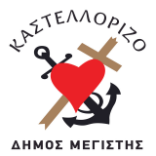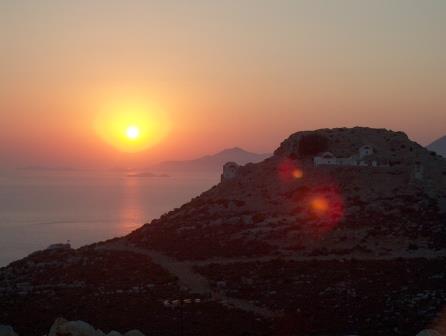
First Inhabitants
The discovery of remnants of isostructural and polygonal as well as stone tools from pyrites (Museum of Rhodes), dates back to at least the Neolithic era (14,000-9,000 BC). The Cyclopean Walls with poached or carved tombs and the discovery of many Greek inscriptions, probably as the first permanent inhabitants of the island the Dorians. Then the Phoenicians and especially the Mesominoan and Mycenaean era leave their passage, as evidenced by the excellent art golden wreath found in a sarcophagus which was handed by the islands inhabitants in the early 20th century to the Archeological Museum of Athens where it is kept.

Name of the island
Megisti, Kastellorizo according to the historical periods we refer to, we find it with the following names:
Cisthenes (Strabo)
Megisti (Ptolemais, Plinios)
Mayas (Arabs)
Mays (Turks)
CASTEL-ROUX, CASTELLORIZO, ILE DE CASTELLORIZO (French)CASTELLO ROZZO, CASTELLO RUGIO, CASTEL ROSSO (Italian).
There are doubts about the name given by Strabonas to Ancient Cisthenes. However, in the map of Great Greece drawn up by Rigas Feraios, it is mentioned only as Kisthenes. Also the first teacher of the free “Tripolitsa” honored in various ways by Ioannis Kapodistrias, is referred to as Ioannis Kisthenios.
Kastellorizo is not a paraphrase of the Italian Castello Rugio contrary to what is believed.It is Byzantine from the name kastellos or kastelli and from the root, as it was built on the roots of the mountain.The knights who conquered the island in 1306 did not understand what Kastellorizo meant and they paraphrased its name to Castello Rougio.
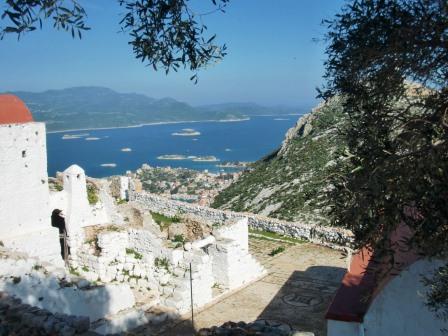
History
Throughout its life, the island has been affected by historic events in different eras. It is located geographically at the crossroads of the development of civilization in the Eastern Mediterranean Basin.These dominations were the cause of the repeated destructions and looting suffered by the island.However its people fought with bravery, and inspired the admiration of all.
Exceptionally patriotic its inhabitants never abandoned it. Filergioi and Thalassoulikoi, after every such catastrophe started to store goods and gold
The destruction began from the beginning to create and save terrestrial goods and especially gold.
Savary writes, “so great is the love of the inhabitants for their island that they never leave it…”
For the prosperity of the island Stochove writes in 1630 “… only few Greeks live with such prosperity as the inhabitants of Kastellorizo…”
Despite their financial strength and naval strength, they were never arrogant, and were not lured into pirate adventures. On the contrary, they have always been compassionate and hospitable, with their faith in religion and family firmly rooted.
As quiet people who love nature , inhabitants are favored by the occasionally sovereign sultans who, put them under their protection by firmania
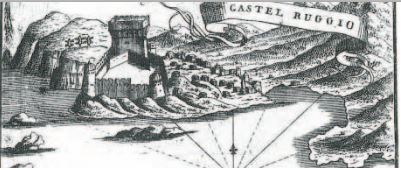
Byzantine period
After the partition of the Roman state, the island was brought to Byzantium under the flag of which prospered, for several centuries, under the Theme of the Knights Hospitaller.The passage of Saint Helena from the island during her journey to the Holy Land to find the Holy Cross is noted. According to tradition she built a small temple on the island which is now covered by the imposing Temple of the patron saint of Constantine and Helena.
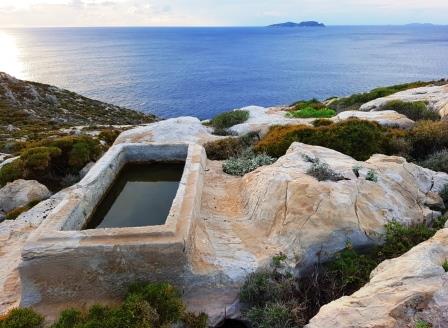
Early Dynastic Period
Remarkable neolithic traces have been found on the island, that residents called “astropelekia”. There are still Cyclopean walls of the Mycenaean era on the Hill of Vigla. On the plateau of Agios Georgios a wreath of Mycenaean art was discovered in a golden sarcophagus which as mentioned above, is kept in the Archeological Museum of Athens.
On Ro Island a ceramic tomb from the 11th century BC was found. During this period Megisti belonged to the municipality of Perea which was gradually controlled by Rhodes.
Despite its close proximity to the coast of Lycia, the island was never an administrative part of the island in ancient times and had no other dependencies, apart from commercial relations. As it can be seen from the inscriptions found, the Lycians were bilingual (Greek and Lycian) and the island’s monolingual (Greek).
The Rhodian power is overthrown by the tyrant of Halicarnassus, and after him by the admirals of Alexander the Great, after the death of whom, all the islands of the Aegean including kastellorizo come under the jurisdiction of Ptolemy and later the Romans. During the period of Roman rule, the island again gains a kind of autonomy. After a few years the island is occupied by the pirates Kilickes and Carres and becomes their base.
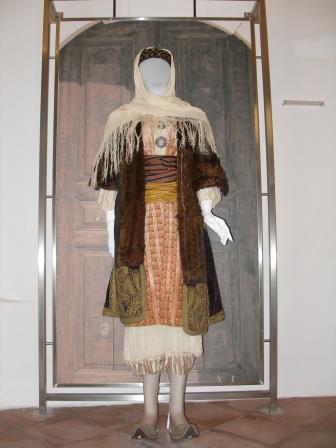
Revolution of 1821
Being the only islanders of the Dodecanese who prosper and enjoy special privileges at this time, when the general uprising sounded, the islanders were the first to embrace the ideals of the Filiki Eteria.The population of the island was 2,500 souls at that time . Women and children were immediately sent to Kasos, Karpathos and Amorgos for safety, while merchant ships were tranformed into warships. With these in a daring expedition, they endured Turkish ships in the Gulf of Antalya. With their ships they flanked the fleets of the Aegean islands and actively participated in the sea operations for the liberation of the homeland.As Palion Patron Germanos quotes in his Memoirs of 1837 about the action of the Kastellorizotika ships “… with their ships they caused horror and terror to the enemy and captured many Turkish merchant ships…”
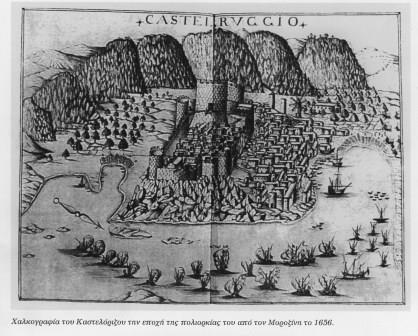
Franks. Venetians. Turks
Arriving at the period of the Crusades a haunt of adventurers began in the developing countries of Europe supposedly for the liberation of Jerusalem, when in fact they aimed to destroy the Byzantine Empire where civilization, prosperity, learning and development flourished.
During the 2nd and 3rd Crusade in 1147 and 1189 respectively, the island suffered the greatest damage in its history. In 1306 the island was occupied by the Knights Hospitaller and in 1440 by the Egyptians, with Celal el Din in charge of the Egyptian fleet. The island was then ruined, its inhabitants were taken prisoners to the East and the castle of Ai-Nikola which had been repaired by d’Erentia was destroyed.
In 1461 the island was occupied by the Catalans, in 1470 it was occupied by the King of Naples, in 1480 it was deserted by the fear ofTurks. In 1498 the King of Naples retrieved it, while in 1512 the island was flown by the Spanish flag. In 1522, when Rhodes was occupied by the Turks, the island remained in Christian hands and in 1570 it was ruled by the Venetians. In 1635 he passed the island into the hands of the Turks and in 1659 the Venetians reconquered it destroying his castle with the legendary Morosini.
The island is also not missing during this period, and pirates use it as their refuge, mainly Maltese pirates.
We see that during this period Turks, Venetians and pirates alternate to the extreme rock, underlining the special value of its geographical location.
These were, of course, the reasons that impeled Lambros Katsonis in 1788 to conquer the castle of the island and then tear it down.
In 1792 the Turks returned to remain until the Revolution of 1821. During this period, the normal development of life on the island is restored. The Navy begins to flare up, which after the National Revolution will reach its maximum peak.
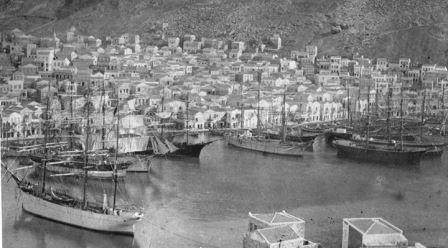
Second Ottoman Empire
Due to the London Protocol of 1830, the Dodecanese stayed outside the Greek territory and a new period of Turkish rule began on the island. During this new period the performance of the island in shipping and trade was particularly important and contributed to the development of the island. Throughout the 19th century, the Castellorizians had a significant naval force of 165 ships of 24,000 tons (42,000 GRT), except, of course, for barrel wreaths, bridges and other smaller vessels.
At the beginning of the 20th century, the Castellorizians with their inclination to work have grown, carrying along with others their commercial activity to the opposite Asia Minor coast, where they create their own flourishing colonies in Kalamaki, Phoenix, Antifellos and Myra, while their fleet plowes the seas and transports the goods to the island “of Prussa and Venice”
The population of the island is approaching 15,000.
Examples of the prosperity of this island were the completely free healthcare and education, with the following institutions:
Santrapia Urban School
(Eight teachers, 480 pupils)
All girls School(Seven teachers, 400 students)
Mixed School, for young boys and girls
Kindergarten (One kindergarten and 100 infants)
This info is taken from the magazine ‘’filia’’ which used to be published in the island
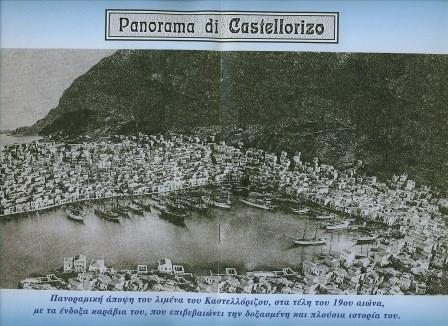
Balkan wars
The Castellorizians could not remain unmoved by the successes of the Greek army, liberating homelands and islands which for centuries remained enslaved. A committee headed by Mich. C. Petridis was sent and handed a letter asking for the union with the motherland to Prime Minister Eleftherios Venizelos. The Prime Minister was not encouraging due to the fact that the geographical location of the island required naval forces for protection, which he did not dispose of. The events impeded diplomatic actions and on the 1st of March in 1913, 30 armed Cretans led by Daskalaki and two Castellorizians sent by Foreign Ministry Chief John Dragoumis arrived on the island. The inhabitants of the island being in a state of excitement took up weapons, arrested the Turkish guard and raised the Greek Flag, ignoring the consequences due to the immediate proximity to Turkey.
On 29 March 1913 ,despite the strong reactions of the Greek government, a joint resolution was issued in Agios Konstantinos “declaring irreversible the unification of the island with Mother Greece”. After all of this, the Greek Government sent an official Greek Commander who arrived on 1 August 1913, The decisions the Castellorizians made ,ended the period, as mentioned above, of the prosperity of the island.
The French, taking advantage of the disastrous situation on the island, disembarked forces on 28 December 1915 and captured it to use it as an advanced base for their military operations in Syria and Cilicia.
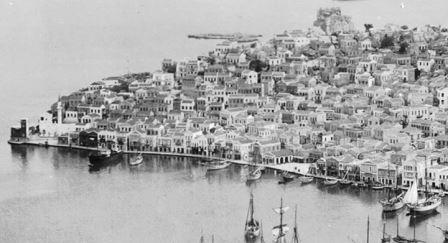
And while the Castellorizians expected the end of World War I and the withdrawal of the French to join mother Greece, as they were promised, the French used to receive help from the inhabitants, on 1 March 1921 France gave the island as if it were a fief to Italy.
The Castellorizians, disappointed ,under the conditions of the Italian Fascist occupation, with persecutions, oppression and exiles, begin to leave the island and go to Rhodes, Piraeus, Egypt, America and Australia.
in 1910 there were approximately 15.000 inhabitants, while in 1941 only 1.500 remained. The Italian Fascist occupation did not succeed in the de-Hellenization of the few inhabitants. When in November 1941 the Allies, in an act of diversion, occupied for 24 hours the island, the inhabitants filled the streets with “Christos Anestis” and the houses flooded with Galanolfeki. They took down the flag of the oppressor, burnt it and in its place raised the Honored and Glorified Greek Flag. This lasted only 24 hours,as the next day the allied troops left, the dynasty tortured the defenseless Castellorizians. Beatings, imprisonment and exile followed.
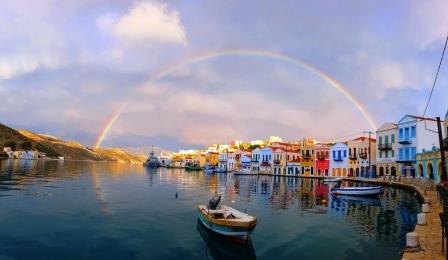
The liberation
And when that morning of September 13, 1943, the Destroyer “Admiral Kountouriotis” proudly sailed into the port of the island, bringing the message of Liberty, with much hesitation and compassion, the inhabitants, recalling the pain they suffered two years ago, could not believe what was happening.
When they were finally convinced that the hour of Freedom had arrived, which for more than eight centuries was absent, they raised the Greek flags, they sang our National Anthem and together with the crew of the Greek War they went to Agios Konstantinos to thank God for the day they were offered.
This did not last long because soon the German planes began to bomb the island causing great damage.
Immediately the allies moved the few inhabitants, who remained, through Cyprus, to Palestine. Kastellorizo was the first part of the Greek territory to be liberated and used as an advanced base of expedition to liberate the other islands of the Dodecanese.
In the meantime, all the tribes of the British Commonwealth began to cross the island, from Indians, Pakistanis to Maori, fulfilling their military obligations to their empire.
This crowd of young adventurers, after those of the Crusades, facing the treasures that hid the abandoned houses of the Castellorizians, started the “looting” until there was nothing left. Their prey was sold in the bazaars of the Middle East where the foreign Castellorizians saw objects that adorned their houses being for sale!
Immediately after the end of the War on the European Front 9 May 1945, the displaced and tortured Castellorizians are insistently asking to return to their island in order to relax and find the old good and calm rhythm of their lives.
Those responsible for the plundering of the mansions of the island panicked and in order to cover for their responsibilities, they set fire and burnt the entire neighborhood that included about 1400 houses.
When the Castellorizians returned to their homes, about 900 who survived after the fire that broke out on the ship carrying the third mission and thirty-five souls were lost, among them babies and children, they could not believe what they saw in front of their very eyes.
Nothing was left from all the hard work done by several generations .The following description of Athena Tarsouli in the third book of the Dodecanese, Volume C page 347 for the situation that prevailed on the island immediately after the end of the war, perfectly gives the picture and with no need for more more words… “Once home of a vigorous life of wealth and bliss, now a victim of an evil, jealous fate , like a wild tornado sowing havoc and demolished all the pre existing happiness state into amorphous ruins….”
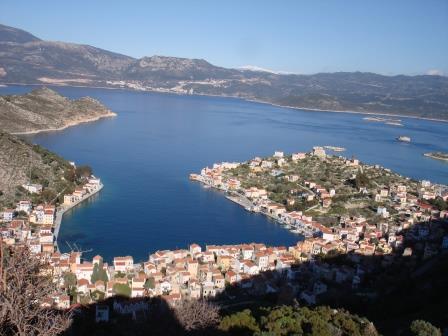
To sum up:
Life in Megisti, Kastellorizo dates from 14,000 to 9,000 BC. The Dorians followed the Phoenicians and then the Mesominoan and Mycenaean era.
After that the island belonged to the jurisdiction of Rhodes, which then passed to the tyrant of Halicarnassus, and after him the Generals of Alexander the Great with the Ptolemies and after them it was occupied by the Romans.
After several years it was occupied by the pirates Kilickes and Karez and became their base.
After the division of the Roman state, the island went under the control of Byzantium.
During the 2nd and 3rd Crusade 1147 and 1189 respectively as the Crusaders moved by sea,the island suffered the greatest disasters of its history.
In 1306 the island was occupied by the Knights Hospitaller of Rhodes and
1440 by the Egyptians
1461 the island is occupied by the Catalans,
1470 was occupied by the king of Naples,
1480 is devastated by the fear of the Turks, in
1498 is recovered by the King of Naples, while in the
1512, the Spanish flag flew on the island, the
1522 when Rhodes was occupied by the Turks the island remained in Christian hands and in
1570 it ruled by the Venetians, in
1635 the island passed into the hands of the turks and the
1659 the Venetians regained its control by destroying the castle.
In 1788, Lambros Katsonis took over the castle of the island and then tore it down.
In 1792 the Turks returned and remained until the revolution of 1821.
On 1st March 1913, 30 armed Cretans led by Daskalakis arrived on the island and liberated the island.
The French, taking advantage of the disastrous situation on the island, took over the island on 28 December 1915 to use it as an advanced base for their military operations in Syria and Cilicia.
On 1 March 1921, France ceded the island to Italy.
In November 1941, the allies, in an act of diversion, occupied the island for 24 hours.
In the morning of 13th of September 1943, the Destroyer “Admiral Kountouriotis” sailed proudly into the port of the island, bringing the message of Liberty.
Immediately after the war ended on 9 May 1945 the displaced and tortured Castellorizians returned to their island.
